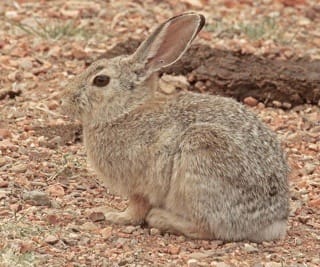This guide initially displays all common mammals. Use the selectors below to view mammals of a particular shape, include rare mammals, or search for them by name.
Mammals are defined as warm-blooded vertebrates with hair or fur and sweat glands — in the females mammary glands, modified sweat glands, produce milk to nourish the young. Most mammals develop a placenta which enables the feeding of the fetus during gestation and give birth to live young. In addition, although most mammals walk on land, many have specific adaptations that allow them to swim, fly, leap between tree branches or even dig extensive tunnels. Many wild mammals are used for both food and fur. while other have been domesticated for their agricultural and scientific importance.
New Mexico ranks high for mammalian diversity in the states in the US and the Pajarito Plateau is home to many of these species. This guide describes all of the larger wildlife found in the area as well as the more common smaller animals with the most abundant being rodents. Local species range from carnivores like the mountain lion and bobcat to ruminants like elk and deer to to several varieties of bats.
Mammal References
Biota Information System of New Mexico
Bogen et al. 1998 Continued Studies of Bat Species of Concern in the Jemez Mountains, New Mexico [PDF]
eNature
Frey et al. 2006 Checklist of New Mexico Mammals [PDF]
New Mexico Tech Mammalian Field Guide
Smithsonian National Museum of Natural History North American Mammals
Threatened, Endangered and Sensitive Species Profile – Los Alamos Laboratory Lands [PDF]
Tyrell and Brack 1992 Survey for Bats in the Los Alamos National Environmental Research Park
Subject Area Experts (all guides)
Steve Cary (butterflies)
Beth Cortright (insects)
Terry Foxx (invasive plants)
Leslie Hansen (mammals)
Richard Hansen (fish, mammals)
Dorothy Hoard (butterflies, trees)
Chick Keller (flowers, herbarium)
Shari Kelley (geology)
Kirt Kempter (geology)
Garth Tietjen (reptiles)
David Yeamans (birds)
Web Development and Content Management
Pat Bacha
Jennifer Macke
Graham Mark
Akkana Peck
Contact
Please contact us for local nature questions and sightings. We welcome comments, corrections, and additions to our guides.
For more information about local nature, please visit our Nature Blog or subscribe to PEEC This Week.
Make Selection
 Photo: Jerry Oldenettel |  Desert Cottontail(Sylvilagus audubonii)Family: Leporidae (Hares and Rabbits) Size: 14.5 - 19.5 in (37 - 50 cm) Status: native; common Habitat: brush areas, desert, towns The Desert Cottontail is most active during the day but can be seen at dawn and dusk. It will hide in an abandoned rodent burrow or a shallow depression in the ground. Desert Cottontails mainly feed on grasses but eat leaves from shrubs as well as cacti and acorns. They get their water primarily from the food they eat or from dew. Like all rabbits and hares, they are coprophagic, i.e., eating their own feces to allow for more nutrition to be extracted from their food. They are prey animals for raptors, carnivorous mammals, snakes and even humans. This has led them to be cautious; they either freeze when alarmed or run away when startled at high speeds in a zigzag pattern. They can breed year-round depending on the food supply and the young mature quickly. Tracks Info Photos Distribution Featured |
 Photo: Josip Loncaric |  Mountain Cottontail, Nuttall's Cottontail(Sylvilagus nuttallii)Family: Leporidae (Hares and Rabbits) Size: 13.8 - 15.4 in (35 - 39 cm) Status: native; common Habitat: montane coniferous forests, open areas with lots of herbaceous vegetation The Mountain Cottontail is primarily active at dawn and dusk but always stays close to cover. It spends much of its time feeding on vegetation like sagebrush, juniper and grasses. It will even eat twigs and bark during winter. The cottontail’s feet are covered with long hair to protect it from the cold and the inside of its ears are furry. The Mountain Cottontail is similar to the Desert Cottontail but it is smaller and has shorter ears. Mountain Cottontails make cavity nests lined with fur. They can produce several litters each year. The young rabbits, as opposed to hares, are born blind and hairless. Tracks Info Photos Distribution Featured |
